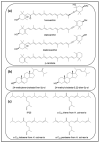What Was Old Is New Again: The Pennate Diatom Haslea ostrearia (Gaillon) Simonsen in the Multi-Omic Age
- PMID: 35447907
- PMCID: PMC9033121
- DOI: 10.3390/md20040234
What Was Old Is New Again: The Pennate Diatom Haslea ostrearia (Gaillon) Simonsen in the Multi-Omic Age
Abstract
The marine pennate diatom Haslea ostrearia has long been known for its characteristic blue pigment marennine, which is responsible for the greening of invertebrate gills, a natural phenomenon of great importance for the oyster industry. For two centuries, this taxon was considered unique; however, the recent description of a new blue Haslea species revealed unsuspected biodiversity. Marennine-like pigments are natural blue dyes that display various biological activities-e.g., antibacterial, antioxidant and antiproliferative-with a great potential for applications in the food, feed, cosmetic and health industries. Regarding fundamental prospects, researchers use model organisms as standards to study cellular and physiological processes in other organisms, and there is a growing and crucial need for more, new and unconventional model organisms to better correspond to the diversity of the tree of life. The present work, thus, advocates for establishing H. ostrearia as a new model organism by presenting its pros and cons-i.e., the interesting aspects of this peculiar diatom (representative of benthic-epiphytic phytoplankton, with original behavior and chemodiversity, controlled sexual reproduction, fundamental and applied-oriented importance, reference genome, and transcriptome will soon be available); it will also present the difficulties encountered before this becomes a reality as it is for other diatom models (the genetics of the species in its infancy, the transformation feasibility to be explored, the routine methods needed to cryopreserve strains of interest).
Keywords: HBIs; Haslea ostrearia; auxosporulation; diatoms; epigenetics; genomics; marennine; phylogeny; transcriptome.
Conflict of interest statement
The authors declare no conflict of interest.
Figures














Similar articles
-
Benthic Diatom Blooms of Blue Haslea spp. in the Mediterranean Sea.Mar Drugs. 2023 Nov 8;21(11):583. doi: 10.3390/md21110583. Mar Drugs. 2023. PMID: 37999407 Free PMC article.
-
Marennine, promising blue pigments from a widespread Haslea diatom species complex.Mar Drugs. 2014 May 28;12(6):3161-89. doi: 10.3390/md12063161. Mar Drugs. 2014. PMID: 24879542 Free PMC article. Review.
-
Antioxidant and free radical scavenging properties of marennine, a blue-green polyphenolic pigment from the diatom Haslea ostrearia (Gaillon/Bory) Simonsen responsible for the natural greening of cultured oysters.J Agric Food Chem. 2008 Aug 13;56(15):6278-86. doi: 10.1021/jf073187n. Epub 2008 Jul 16. J Agric Food Chem. 2008. PMID: 18636683
-
Spectral Properties of Marennine-like Pigments Reveal Minor Differences Between Blue Haslea Species and Strains.Molecules. 2024 Nov 6;29(22):5248. doi: 10.3390/molecules29225248. Molecules. 2024. PMID: 39598639 Free PMC article.
-
Comments on recent progress toward reconstructing the diatom phylogeny.J Nanosci Nanotechnol. 2005 Jan;5(1):57-62. doi: 10.1166/jnn.2005.007. J Nanosci Nanotechnol. 2005. PMID: 15762161 Review.
Cited by
-
Complete mitochondrial genome and draft chloroplastic genome of Haslea ostrearia (Simonsen 1974).Mitochondrial DNA B Resour. 2023 Oct 13;8(10):1092-1096. doi: 10.1080/23802359.2023.2268747. eCollection 2023. Mitochondrial DNA B Resour. 2023. PMID: 37849652 Free PMC article.
References
-
- Chapman R.L. Algae: The world’s most important “plants”—An introduction. Mitig. Adapt. Strateg. Glob. Chang. 2010;18:5–12. doi: 10.1007/s11027-010-9255-9. - DOI
-
- Benemann J.R., Woertz I., Lundquist T. Autotrophic microalgae biomass production: From niche markets to commodities. Ind. Biotechnol. 2018;14:3–10. doi: 10.1089/ind.2018.29118.jrb. - DOI
-
- Borowitzka M.A. High-value products from microalgae—Their development and commercialisation. J. Appl. Phycol. 2013;25:743–756. doi: 10.1007/s10811-013-9983-9. - DOI
Publication types
MeSH terms
Substances
Grants and funding
- CMBR, MIS 5002670/European Union and Greece
- RADIO, 483/Hellenic Foundation for Research and Innovation (HFRI) and the General Secretariat for Re-search and Technology (GSRT)
- 120Z514 and 120Z247/The Boğaziçi University and The Scientific and Technological Research Council of Turkey (TÜ-BİTAK)
- RFI - Food for tomorrow - Cap Aliment/Région des Pays de la Loire, France
- 734708/GHANA/H2020-MSCA-RISE-2016/European Union
LinkOut - more resources
Full Text Sources
Medical
Miscellaneous

